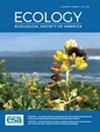Fish and invertebrate communities show greater day–night partitioning on tropical than temperate reefs
IF 4.4
2区 环境科学与生态学
Q1 ECOLOGY
引用次数: 0
Abstract
Diel partitioning of animals within ecological communities is widely acknowledged, yet rarely quantified. Investigation of most ecological patterns and processes involves convenient daylight sampling, with little consideration of the contributions of nocturnal taxa, particularly in marine environments. Here we assess diel partitioning of reef faunal assemblages at a continental scale utilizing paired day and night visual census across 54 shallow tropical and temperate reefs around Australia. Day–night differences were most pronounced in the tropics, with fishes and invertebrates displaying distinct and opposing diel occupancy on coral reefs. Tropical reefs in daytime were occupied primarily by fishes not observed at night (64% of all species sighted across day and night, and 71% of all individuals). By night, substantial emergence of invertebrates not otherwise detected during sunlit hours occurred (56% of all species, and 45% of individuals). Nocturnal emergence of tropical invertebrates corresponded with significant declines in the richness and biomass of predatory and herbivorous diurnal fishes. In contrast, relatively small diel changes in fishes active on temperate reefs corresponded to limited nocturnal emergence of temperate invertebrates. This reduced partitioning may, at least in part, be a result of strong top‐down pressures from fishes on invertebrate communities, either by predation or competitive interference. For shallow reefs, the diel cycle triggers distinct emergence and retreat of faunal assemblages and associated trophic patterns and processes, which otherwise go unnoticed during hours of regular scientific monitoring. Improved understanding of reef ecology, and management of reef ecosystems, requires greater consideration of nocturnal interactions. Without explicit sampling of nocturnal patterns and processes, we may be missing up to half of the story when assessing ecological interactions.鱼类和无脊椎动物群落在热带珊瑚礁上比温带珊瑚礁表现出更大的昼夜划分
动物在生态群落中的昼夜划分得到广泛承认,但很少量化。对大多数生态模式和过程的调查涉及方便的日光取样,很少考虑夜间分类群的贡献,特别是在海洋环境中。在这里,我们利用对澳大利亚54个浅层热带和温带珊瑚礁的昼夜视觉普查,在大陆尺度上评估了珊瑚礁动物群的昼夜划分。昼夜差异在热带地区最为明显,鱼类和无脊椎动物在珊瑚礁上表现出截然不同的昼夜占用。白天的热带珊瑚礁主要由夜间未观察到的鱼类占据(占白天和黑夜都能看到的所有物种的64%,占所有个体的71%)。到了晚上,大量的无脊椎动物出现了(56%的物种和45%的个体)。热带无脊椎动物的夜间出现与捕食性和食草性日间鱼类的丰富度和生物量的显著下降相对应。相比之下,在温带珊瑚礁上活动的鱼类的相对较小的昼夜变化对应于温带无脊椎动物夜间出现的有限。这种减少的划分可能,至少在一定程度上,是由于鱼类对无脊椎动物群落施加了强大的自上而下的压力,要么是捕食,要么是竞争干扰。对于浅层珊瑚礁来说,死亡周期触发了不同的动物群落的出现和消退以及相关的营养模式和过程,否则在数小时的定期科学监测中就不会被注意到。提高对珊瑚礁生态的理解和对珊瑚礁生态系统的管理,需要更多地考虑夜间的相互作用。如果没有明确的夜间模式和过程的采样,我们在评估生态相互作用时可能会错过一半的故事。
本文章由计算机程序翻译,如有差异,请以英文原文为准。
求助全文
约1分钟内获得全文
求助全文
来源期刊

Ecology
环境科学-生态学
CiteScore
8.30
自引率
2.10%
发文量
332
审稿时长
3 months
期刊介绍:
Ecology publishes articles that report on the basic elements of ecological research. Emphasis is placed on concise, clear articles documenting important ecological phenomena. The journal publishes a broad array of research that includes a rapidly expanding envelope of subject matter, techniques, approaches, and concepts: paleoecology through present-day phenomena; evolutionary, population, physiological, community, and ecosystem ecology, as well as biogeochemistry; inclusive of descriptive, comparative, experimental, mathematical, statistical, and interdisciplinary approaches.
 求助内容:
求助内容: 应助结果提醒方式:
应助结果提醒方式:


